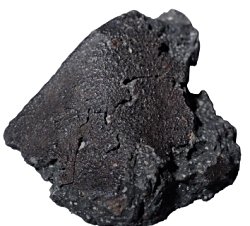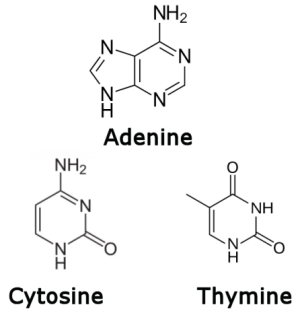
 | DNA and RNA building blocks found in carbonaceous meteorites. |
How life started on Earth is still a subject of intense research, and many scientists believe that the chemicals which were precursors to terrestrial life were brought to Earth by extraterrestrial bodies. Given this belief, it is perhaps quite surprising that some of the nucleobases which are needed to make DNA and RNA are really hard to come by. However, recent studies carried out on three meteorites - all carbonaceous chondrites - have led to success in finding pyrimidine nucleobases.

For life on Earth to start we need all the necessary chemical blocks beginning with the most basic, which are the nucleobases. There are five essential nucleobases; also referred to as 'primary' or 'canonical'. These are adenine(A), cytosine (C), guanine (G), thymine (T) and uracil (U). They function as fundamental units of the genetic code with bases A, G, C, and T which are found in DNA and A, G, C and U which are the building blocks of RNA. These nucleobases have the ability to form pairs and to stack one upon another which allows for long-chain helical structures such as deoxyribonucleic acid (DNA) and ribonucleic acid (RNA).
Adenine and guanine have a two-ring structure and are referred to as purines. They are larger than cytosine, thymine and uracil, which each have a single ring. The latter are pyrimidines. Although purines have been previously isolated from meteorites, pyrimidines have not been found by earlier studies.
In the latest studies, recently published in Nature Communications (ref) researchers looked at samples from three carbonous chondroid meteorites. Two were specimens from the Murchison meteorite along with samples from the Murray and Tagish Lake meteorites.
The Murray meteorite crashed to Earth on September 20, 1950. After a brilliant fireball was seen in the neighboring state of Illinois, the meteoroid exploded at high altitude and, after a number of sonic booms were heard, several pieces of the meteorite were recovered some 15 kilometers east of Murray, Kentucky.
The Murchson meteorite fell in Australia in 1969 near Murchison in Victoria. Due to its massive size (over 100kg) and the fact that it was seen when it fell, the Murchison meteorite is one of the most studied of all meteorites.
The most recent of the studied meteorites is the Tagish Lake meteorite which fell in northern British Columbia (Canada) on January 18, 2000. It is believed that the rock that entered Earth’s atmosphere was a massive 5 meters in diameter and weighed about 105 tonnes. Although most of the rock broke up on entry, many fragments lended on frozen Tagish Lake.
The samples collected from those three meteorites were analyzed using high-performance liquid chromatography (this technique allows for selective and highly sensitive detection of trace and molecular-species specific compounds) in combination with electrospray ionization high-resolution mass spectrometry (a technique to generate ions for mass spectrometry using electrospray by applying a high voltage to a liquid to produce an aerosol). In addition the nucleobases in aqueous extracts of different staples from the Murchison meteorite were compared with aqueous soil samples from the meteorite fall site. This was to eliminate potential sources of terrestrial contaminants. The scientists were able to detect purine nucleobases in all three meteorites and showed that the results were not due to contamination. Interestingly, in the Murray and Murchson extracts the dominated nucleobase was guanine, but the most abundant purine molecule found in the Tagish Lake meteorite was adenine.
The researchers have also found all three of the pyrimidine nucleobases (cytosine (C4H5N3O), uracil (C4H4N2O2), and thymine (C5H6N2O2)). The Tagish Lake extract generally shows less diversity of purine and pyrimidine molecules compared with the Murchison and Murray extracts, and their absolute concentrations were generally lower than those of the other meteorite extracts.
According to Danny Glavin, an astrobiologist from NASA’s Goddard Space Flight Center in Maryland and the co-author in this study, the finding of a complete set of nucleobases necessary for building of DNA and RNA in meteorites shows that meteorites could have been an important source of the organic chemicals necessary for the initiation of life on Earth.
"There is still much to learn about the chemical steps that led to the origin of life on Earth - the first self-replicating system," Glavin said. "This research certainly adds to the list of chemical compounds that would have been present in the early Earth's prebiotic [that is: existing before the emergence of life] soup."
"The present results may not directly elucidate the origin of life on the Earth," added Oba - the lead author of this study, "but I believe that they can improve our understanding of the inventory of organic molecules on the early Earth before the onset of life."
Journal Reference:
| _______________________________ | ||||
| Home | | | Shopping | | | Database |
© Biscuit Software 2004-2019
All rights reserved